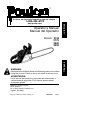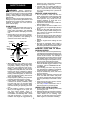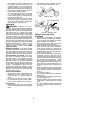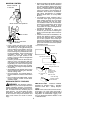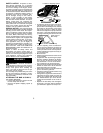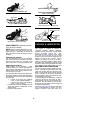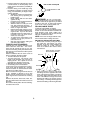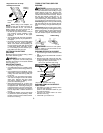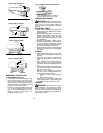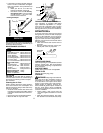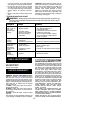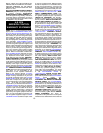
9
Opening
of felling
cut
Closing of
notch
Hinge holds tree on stump
and helps control fall
NOTE:
Before felling cut is complete, use
wedges to open the cut when necessary to
control the direction of fall. Use wood or
plastic wedges, but never steel or iron, to
avoid k ickback and chain damage.
S
Be alert to signs that the tree is ready to
fall: Cracking sounds, widening of the
felling cut or movement in the upper
branches.
S
Astree startsto fall, stop saw,put itdown,
and get awayquickly onyour planned re-
treat pat h.
S
Beextremely cautious with partially fallen
trees that may be poorly supported.
When a tree doesn’t fall completely, set
the saw aside and pull down the tree with
a cable winch, block and tackle, or trac-
tor. Toavoid injury, donot cutdown apar-
tially fallen tree with your saw.
CUTTING A FALLEN TREE
(BUCKING)
Bucking is the term used for cutting a fallen
tree to the desired log size.
WARNING:
Do not stand on the log
being cut. Any portion can roll causing loss
of footing and control. Do not stand downhill
of the log being cut.
IMPORTANT POINTS
S
Cut only one log at a time.
S
Cut shattered wood very carefully; sharp
pieces of wood could be flung toward op-
erator.
S
Use a sawhorse to cut small logs. Never
allow another person to hold the log while
cutting and never hold the log with your
leg or foot.
S
Do not cut in an area where logs, limbs,
and roots are tangled such as in a blown
down area. Drag the logs into a clear
area before cutting by pulling out ex-
posed and cleared logs first.
S
Make the first bucking cut 1/3 of the way
through thelogand finish with a2 /3 cuton
the opposite side. As the log is being cut,
it will tend to bend. The saw canbecome
pinched or hung inthe logif you make the
first cut deeper than 1/3of thediameter of
the log.
S
Give special a ttention tologs under strain
to prevent the saw from pinching. Make
thefirstcut onthe pressuresidetorelieve
the stress on the log.
TYPES OF CUTTING USED FOR
BUCKING
WARNING:
If sawbecomes pinched
or hung in a log, don’t try to force it out. You
can lose control of the saw resulting in injury
and/or damage to the saw. Stop the saw,
drive a wedge of plastic or wood into the cut
until the sawcan be removed easily. Restart
the saw and carefully reenter the cut. To
avoid kickback and chain damage, do not
use ametal wedge. Do notattempt to restart
your saw w hen it is pinched or hung in a log.
Overcutting begins onthe t opsideof thelog
with the bottom of the saw against the log.
When overcutting use light downward pres-
sure.
Undercutting involves cutting on theunder-
side of the l ogwith top of sawagainst thelog.
When undercutting use light upward pres-
sure. Hold saw firmly and maintain control.
The saw will tend to push back toward you.
Overcutting Undercutting
WARNING:
Never turn saw upside
down to undercut. The saw cannot be con-
trolled in this position.
BUCKING WITHOUT A SUPPORT
S
Overcut through 1/3ofthe diameter of the
log.
S
Roll the log over and finish with a second
overcut.
S
Watch for logs with a pressure side. Re-
fer to the illustration on previous page for
cutting logs with a pressure side.
Second cut
First cut on pressure side of log
First cut on pressure side of log
Second cut
BUCKING USING A LOG OR SUP-
PORT STAND
S
Remember your first cut is always on the
pressure side of the log.
(Refer to the illustration below for your
first and second cut)
S
Your first cut should extend 1/3 of the
diameter of the log.
S
Finish with your second cut.



